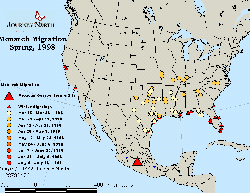Monarch Home Page
Challenge Questions

Today's News

Spring's Journey North

Report Your Sightings

Teacher's Manual

Search Journey North
return to:

Monarch Butterfly Update: April 14, 1998
Today's Report Includes:
- Latest Migration News and Data
- Challenge Question #10
- Where Have All the Monarchs Gone? Challenge Question #11
- Suggestions for Analyzing Data
- Answers from the Monarch Butterfly Expert
- Volunteers Needed: Help Monitor Monarch Reproduction
- Restoring and Protecting Monarch Habitat--At Home and in Mexico
 Latest Migration News
and Data
Latest Migration News
and DataThe migration continues to advance, though slowly and quietly:
04/12/98
"One lonely Monarch was seen drifting in and out of the pine trees," observed Mark Barton in Gainesville, GA (not Florida). "The butterfly weed has just started to emerge. The shoots are only two to three inches tall. Some swamp milkweed, being grown in pots is two feet tall. None of these have eggs on them yet. We are waiting for more Monarchs. There are many flowers in bloom; dogwood, phlox, pansies, azaleas, dandelions, tulips, and verbenum." mmb1984@aol.com
In Texas, the peak has passed and the next generation is now developing. "Our Monarch season is about to come to a slow-down...and then an end by summer," reports Harlen Aschen from Port Lavaca. (heaa@tisd.net)
Challenge Question #10
"Why do you think the monarch season "ends" in Texas during the summer months?"
(To respond to this question, please follow the instructions at the end of this report.)
- Link to Today's Migration Data*
* Special thanks to Monarch Watch and Texas Monarch Watch for contributing data for this study.
Where Have All the Monarchs Gone?
This spring's migration is in stark contrast to last spring's. For example, one year ago today 131 monarchs had been reported compared to only 65 this year. During the first 2 weeks of April alone, there were 59 sightings in 1997 vs. only 23 this year. By this time in 1997, monarchs had been sighted all along the East Coast and as far north as Massachusetts. This map compares the 1997 & 1998 migrations through April 14th:
In addition, by most accounts last fall's migration was the most spectacular in a decade. Why are there apparently so few butterflies now?
Challenge Question #11
"If the monarch population was at a peak last fall, and if the low numbers this spring indicate a smaller population than last spring, when do you think this decline might have occurred and why?"
(To respond to this question, please follow the instructions at the end of this report.)
Suggestions for Analyzing Data
- How far north and east has the migration progressed? Each week, find the latitude and longitude of the northernmost and the northeasternmost sightings.
- How many miles from Mexico has the migration progressed? Assuming all sightings are of monarchs from Mexico, measure the distance each week of the sightings furthest from Mexico.
- How does this spring's migration compare to last spring's? Remember, all records from previous years are stored permanently in the Journey North database where you can access them at any time. Simply press the "owl" button from any page.
- Note to Teachers: See these guiding questions to help students analyze migration data and integrate information about monarchs.
Answers from the Monarch Butterfly Expert
Special thanks to Dr. Karen Oberhauser for providing her time and expertise in responding to your questions this week. You can read this exchange on the WWW:
Volunteers Needed: Help Monitor Monarch Reproduction
 If you'd like to help Dr. Oberhauser answer her own questions
about monarchs, read on. Volunteers are needed this season to help monitor monarch reproduction throughout their
breeding range. You can read more about this study on the Monarch Watch WWW site:
If you'd like to help Dr. Oberhauser answer her own questions
about monarchs, read on. Volunteers are needed this season to help monitor monarch reproduction throughout their
breeding range. You can read more about this study on the Monarch Watch WWW site:
"We need lots of volunteers to help us collect data," says to Michelle Prysby of Dr. Oberhauser's lab at the University of Minnesota. As Prysby explains, the data will be used to answer questions about Monarch ecology during the breeding season. For example:
- How do larval Monarch population densities fluctuate throughout the breeding season in different parts of North America?
- At what larval stages do we see the highest mortality?
- What is the net reproductive potential for summer breeding Monarchs?
- What is the timing of movement of reproductive Monarchs throughout their breeding range?
Restoring and Protecting Monarch Habitat--At Home and in Mexico
Many of you are aware that Lincoln Brower, Karen Oberhauser and Elizabeth Donnelly recently established the Monarch Butterly Sanctuary Foundation (MBSF). The mission of this organization is to help protect monarch overwintering habitat in Mexico.
So that schools can help raise funds for this effort, arrangements have been made with the Community Butterfly Gardens Project. This project introduces butterfly gardening to families through "starter kits" for butterfly gardens, and some of the proceeds will be donated to the MBSF for conservation work in Mexico.
 |
This is a wonderful opportunity to improve conditions for monarchs--in the U.S and Canada, and at the overwintering sites in Mexico as well.
If you are interested in this opportunity, please contact Randy Korb at: Rkorbbio@aol.com or 1-800-799-8189
How to Respond to Today's Challenge Question
1. Address an e-mail message to: jn-challenge-monarch@learner.org
2. In the Subject Line of your message write: Challenge Question # 8
3. In the body of the message, answer the question above.
The Next Monarch Butterfly Migration Update Will be Posted on April 21, 1998.
Copyright 1998 Journey North. All Rights Reserved.




